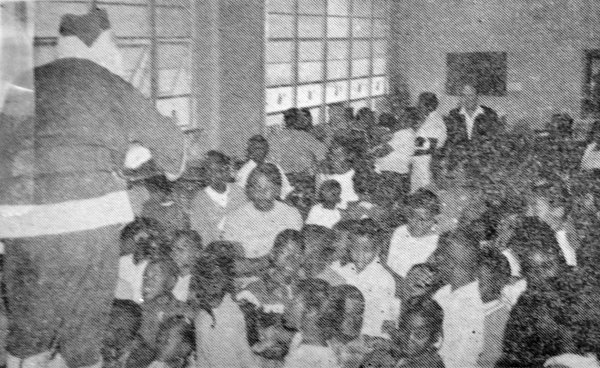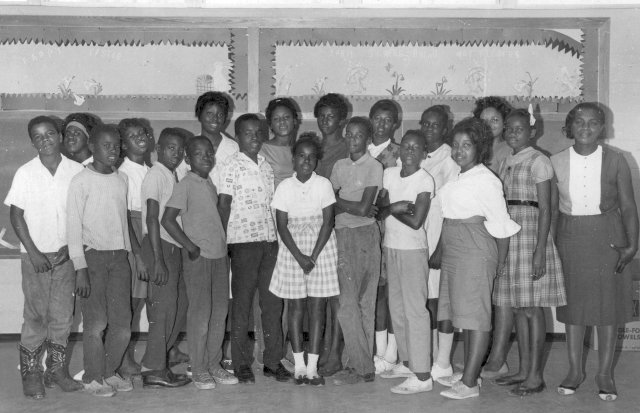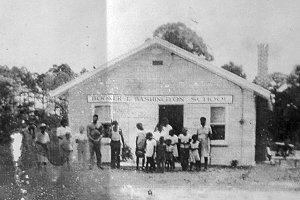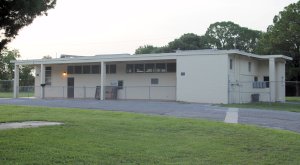HISTORY OF EDUCATION IN PASCO COUNTYBooker T. Washington SchoolSee also: History of the Pine Hill Section This page was last revised on Jan. 10, 2020. A letter in the New Port Richey Press of Oct. 17, 1924, thanking white people for their donations towards the building of the Little Home Baptist Church reported, “We are having day school here now, and again we wish to thank the kind white ladies who have furnished the school room with books for the education of our children.” African-American students in New Port Richey originally attended school in a small building in the Pine Hill section used both as a church and a school. On Oct. 6, 1924, Willie Stanton was appointed the teacher of the Port Richey colored school, according to school board minutes. Laura Burch (b., Mar. 13, 1912; d., March 24, 2008), who came to Pine Hill in 1925 at age 13, recalled in a 1987 interview that there was a school in the Pine Hill section and that it was a church building. She recalled a teacher named Mrs. Hoskin from Tampa and a teacher named Glubble from Plant City. She said she did not recall when the “new school” opened, but said that it was built on U. S. 19 and moved to the Pine Hill section. A history article has: “Until 1944, Copeland taught children of all ages in a single classroom in the wooden Baptist church on Pine Hill Road.” On Dec. 2, 1927, the New Port Richey Press reported:
An article in the New Port Richey Press on Jan. 13, 1928, identified M. E. Houston as the teacher. A 1928-29 roster of pupils for school no. 36 in Port Richey, shows the teacher as M. Stewart and the following pupils:
A notice in the New Port Richey Press of Oct. 18, 1929, has: “There will be a literary program Wednesday night, October 23, at 8 o’clock at the New Port Richey colored public school for the purpose of raising funds to extend the school term. We take this method of inviting the public, both white and colored, to be present and assist us. We assure you that whatever you give will be greatly appreciated, and used for the purpose given. We are attempting to educate the colored youths and thus make better citizens of them. Full length school terms will do most to accomplish this, so please come and bring your friends. — Carrie L. Roberts, teacher. Columbus Fulwood, supervisor.” School board minutes of Feb. 3, 1930, show Carry Roberts as the teacher at colored school no. 36. School board minutes of Sept. 1, 1930, show Grace Bennett as the teacher at the New Port Richey colored school. School board minutes of Oct. 21, 1933, have: “Matter of health conditions at Booker T. Washington school, New Port Richey, referred to superintendent for handling.” School board records show that Ruby Lee Mack was appointed as the teacher at the New Port Richey colored school for the 1938-39 term. Records from May 19, 1941, and June 21, 1943, show Cecilia H. Tyson as the teacher at the Booker T. Washington School.
Records from the late 1940s through at least 1960 show Ruby Lee Copeland as the teacher at the Booker T. Washington School. School opened in August 1953 after board member R. D. Stevenson persuaded the board to reverse the decision by Superintendent Mark St. Clair and the board to close the school. On Dec. 17, 1953, the New Port Richey Press reported that an informal musicale would be held at the Methodist Church to raise funds for playground equipment and a milk fund for the Booker T. Washington school children. Participants were the school children and the United Spiritual Chorus, directed by Laura Burch. On the program were Gladys Wallace, contralto soloist, Samuel Archie, bass soloist, and Annie Laura Williams, readings. This structure stood vacant for a while, and was later the location of Richey Machine Co. On Aug. 17, 1961, a newspaper article reported that the school had 38 pupils.
On Aug. 22, 1963, the New Port Richey Press reported that at least 50 students were expected to attend Booker T. Washington Elementary School this fall, about the same number as last year. It reported that Mrs. Mattie L. Lewis would teach grades 1-4 and Mrs. Ruby Copeland would teach grades 5-8. It reported that the seven students at the high school level would be transported to Tarpon Springs by Mrs. Ella May Winthrop, and then take a bus to Clearwater. On June 2, 1965, the St. Petersburg Times reported:
My Pioneer Days in West Pasco by Julie J. Obenreder has:
Beginning in 1966, African-American students were allowed to attend formerly all-white schools, although many chose not to. In 1967, Booker T. Washington School was closed. It became a kindergarten and was subsequently used for other purposes by the school district. African-American students switched to Richey Elementary School. The photo at the right shows the school as it appeared in 2004. The 1966-67 school year was apparently the first year during which African-American students were allowed to attend Gulf High School. Before then, the small number of African-American students living in New Port Richey attended high school in Tarpon Springs or Clearwater. On April 1, 1993, Ruby Copeland, 79, of Tarpon Springs, died at Tarpon Health Care Center. According to her obituary, “She came here in 1923 from her native Jacksonville. She was a teacher and a member of Mt. Moriah AME Church, Tarpon Springs. Survivors include her husband, Joseph; and several cousins.”  A photo from the Dec. 27, 1962, New Port Richey Press with this caption: “Santa Claus is pictured above passing out gifts to the children of the new Booker T. Washington school on Pine Hill Road in Port Richey at the second annual Christmas party last Friday sponsored by the New Port Richey Rotary Club. The youngsters were also treated to a noon meal by Rotarians, prepared by the Hacienda staff.”  One Teacher Molds GenerationsThis article appeared in the St. Petersburg Times on Feb. 24, 1991. By STEPHEN HEGARTY In some ways it seems like ages ago that Ruby Copeland served as a one-woman teaching staff in the tiny all-African-American Booker T. Washington School in West Pasco. It was during a time when black children attended the one-room schoolhouse on U.S. 19 and didn’t mix with white children in other Pasco schools. It was a time when West Pasco’s black children traveled to Clearwater for high school because the black school only went up to eighth grade. And it was a time when the School Board’s list of annual reappointments separated schools and principals into two categories: white and Negro. But for many in the Pine Hill area of West Pasco, it doesn’t seem so long ago that Ruby Copeland taught in the two incarnations of Booker T. Washington School – first a one-room structure on U.S. 19, later a two-room building on Pine Hill Road. “I remember I was concerned about what kind of an education I was going to get in this little school,” said Arthur Jones, 35, whose family moved to Pasco just before the schools integrated. One year Jones attended the two-room Booker T. Washington School with black children of all ages. The next year, in 1967, he attended school and played football with white children at Gulf High. “I didn’t want to go over there to Gulf and embarrass myself,” Jones said. “But, I went there and I didn’t have to struggle at all. I had the right stuff that Mrs. Copeland gave me. “That one lady could do so much with so many kids. That lady deserves a medal or something.” For most of the approximately 30 years she taught in Pasco, Mrs. Copeland was the teaching staff and principal at the all-black Booker T. Washington School. Although she and her husband, Joe, lived in Tarpon Springs, Mrs. Copeland played a large role in the small black community in West Pasco. For about 25 years, virtually every black child who grew up in West Pasco went through Ruby Copeland’s classroom. Laura Burch, 78, one of the first black settlers in the Pine Hill area in the 1920s, had five children and a couple of her grandchildren attend the Booker T. Washington School, taught by Mrs. Copeland. Later, when desegregation came, Mrs. Burch’s two grandsons were the first black children to attend Richey Elementary School. “She taught the first-graders for a few minutes, then got them busy and taught the second-graders for a few minutes,” Mrs. Burch said. “How did she do it with all those kids? She did it. That’s all I can tell you. She managed.” `She knew all the kids’ Mrs. Copeland, now 77 and living in a nursing home in Tarpon Springs, grew up in Jacksonville and spent some of her childhood in Clearwater. She received a teaching degree from Florida Memorial College, which, at the time, was in St. Augustine. Her first teaching job took her to Brooksville, but she stayed there for just one year before she moved to Pasco, where she became a school principal. She began teaching in Pasco in the late 1930s when the school for black children in West Pasco was in the Union Missionary Baptist Church on Pine Hill. The majority of her long teaching career was spent in the one-room Booker T. Washington School house on U.S. 19, where she acted as teacher, principal, guidance counselor, and friend to her pupils. “She knew all the kids and all the families, and they knew her,” Jones said. “She could take your personal problem, turn it all around, and make it right.” It’s unclear exactly how long West Pasco’s black children attended the one-room Booker T. Washington School. But for about 20 years Mrs. Copeland and the tiny schoolhouse were synonymous with education for the black community. Ruby Copeland’s one-room schoolhouse on U.S. 19 at Ridge Road was closed in 1962. The box-like white building with the tin roof sat vacant for a while. Then in 1966 the Midwest Fabricating Co. bought the property and has used the old structure as an office ever since. That wasn’t the end of the school. The School Board spent $33,896 to build a larger school on Pine Hill Road, less than a mile from the old school. The Booker T. Washington School that opened in 1962 wasn’t much bigger than the old school; it was a two-room schoolhouse. Mrs. Copeland finally got some help. She and teacher Mattie Lewis taught grades one through eight. After eighth grade, black children from West Pasco had to travel to Pinellas County to finish the high school grades. “They wouldn’t let the black children go to Gulf High School in those days,” Mrs. Burch said. She recalled that while her children were in high school, she drove them to Tarpon Springs every weekday morning at 8 a.m. so they could catch a school bus to take them to the school in Clearwater. “We went up and down (U.S.) 19 two times a day for a lot of years,” Mrs. Burch said. The alternative would have been to drive to Dade City to attend the Moore-Mickens School for black students. Some black families in West Pasco couldn’t get their children to Tarpon Springs, so those children were unable to attend high school. “No, it wasn’t easy,” Mrs. Burch said. “But, that’s the way they did it then.” The school closes The new Booker T. Washington School, completed in 1962, was planned as the school for black children in West Pasco for many years into the future. But, that future never came. In 1964, Congress passed the Civil Rights Act. Pasco, and every other school system in the country, was ordered to desegregate. “They had some really long discussions about what to do,” said Betty DeWitt, who, as secretary to the superintendent at the time, wrote the official record of those meetings. “One meeting started in the middle of the afternoon and went to 1 or 2 o’clock in the morning. They had some other business, but a lot of it was discussing desegregation, trying to come up with a plan that would satisfy the courts.” At first, for the 1966 school year, the Pasco County School Board came up with a plan that gave parents and students a choice. For the first time ever in Pasco, black parents could choose to send their children to the white schools. But few did. Most blacks remained in the all-black schools. There were exceptions. Mrs. Burch’s two grandsons attended Richey Elementary that year. But their classmates remained at Booker T. Washington, the neighborhood school. “After they said they could go, a lot of people just didn’t,” Mrs. Burch said. “I don’t know why. There wasn’t a problem.” “There was some reluctance to move,” said Ted Williams, now Pasco’s property appraiser, who started his political career on the Pasco School Board in the mid-1960’s. “The Justice Department came down to negotiate and talk about busing.” Williams recalled that he and some other Pasco school officials met in Tampa with a Justice Department official, a young black lawyer named Albert Hammond. He said it became clear that with the small numbers of black children in West Pasco, busing for integration would mean that only the black children would be bused. “They decided that if we closed the school, that would take care of it,” Williams said. The officials determined the closing of the Booker T. Washington School would force West Pasco blacks to move to the previously all-white schools. The schools would be integrated. The Justice Department would be happy. It worked, but it wasn’t without costs. The following year, Booker T. Washington was shut down and the black students enrolled at the area schools. Unlike Hillsborough and Pinellas counties, Pasco never was ordered by a court to bus schoolchildren to achieve integration. “You know what integration meant – it meant they closed down the black schools,” Mrs. Burch said. “They shouldn’t have done that. To integrate, they sent the black kids to the white schools.” “Some of the leaders in the community said that was destroying the community,” Williams said. “The school was a focal point. “They said, `You’ve got other things in your community. We’ve got the church and the school, and now the school is gone,’” Williams recalled. He said the School Board made an “unofficial agreement that we would keep those schools there and not raze them. I think the black leaders had a great deal to do with making it work.” `She did it all’ As promised in the unofficial agreement, the schools are still there, though they’re clearly not the community focal point they used to be. The newer two-room schoolhouse still sits just down the hill from the Union Missionary Baptist Church, where classes were held in the early 1940s. The school has been used over the years as a center for gifted students and as a center for the Head Start program. Now it’s being used as office space for a student services team. A school bus garage built on the adjacent property north of the school eventually will expand onto the Booker T. Washington property. The first Booker T. Washington School is still used as an office by the Richey Machine company, a branch of Midwest Fabricating. It is largely unnoticed at the busy intersection of Ridge Road and U.S. 19 next to a video store. Ruby Copeland ended her career in 1972 – about five years after the schools desegregated – at Richey Elementary School, where she taught black and white children. She now lives in a nursing home in Tarpon Springs, not far from the neat, two-story home she and her husband, Joe, shared for many years. She has lived in the nursing home for four years, since she suffered a major stroke that left her unable to speak. Her husband of 50 years visits her and speaks to her, sometimes reminiscing, every day. “That school was very important to her,” said Joe Copeland, 78. “For a long time she did it all at the school. She knew everybody and everybody’s kids.” |

 The second location for African-American students to attend school was a
new building at U. S. 19 and Ridge Road in Port Richey. On Aug.
25, 1944, the New Port Richey Press reported that the
Pasco County board of instruction had purchased land on U. S. 19
north of Port Richey to build a new school “for the colored
children of Booker T. Washington section.” This Booker T.
Washington School was dedicated on April 21, 1945. A December
1946 newspaper article gives the location of the Booker T.
Washington School as on highway 19, just north of town. A better photo
of this 1945-62 school, taken in 1963, is
The second location for African-American students to attend school was a
new building at U. S. 19 and Ridge Road in Port Richey. On Aug.
25, 1944, the New Port Richey Press reported that the
Pasco County board of instruction had purchased land on U. S. 19
north of Port Richey to build a new school “for the colored
children of Booker T. Washington section.” This Booker T.
Washington School was dedicated on April 21, 1945. A December
1946 newspaper article gives the location of the Booker T.
Washington School as on highway 19, just north of town. A better photo
of this 1945-62 school, taken in 1963, is  The third site of Booker T. Washington School was a new building
which opened in 1962 on Pine Hill Road. The architect for the
school was Frank P. Patterson of Tampa. The building contractor
was Henry Falany. Dedication of the new school took place on
Oct. 24, 1962. The New Port Richey Press article on Nov.
1, 1962, reported that the school was staffed by two instructors
teaching 50 students.
The third site of Booker T. Washington School was a new building
which opened in 1962 on Pine Hill Road. The architect for the
school was Frank P. Patterson of Tampa. The building contractor
was Henry Falany. Dedication of the new school took place on
Oct. 24, 1962. The New Port Richey Press article on Nov.
1, 1962, reported that the school was staffed by two instructors
teaching 50 students.